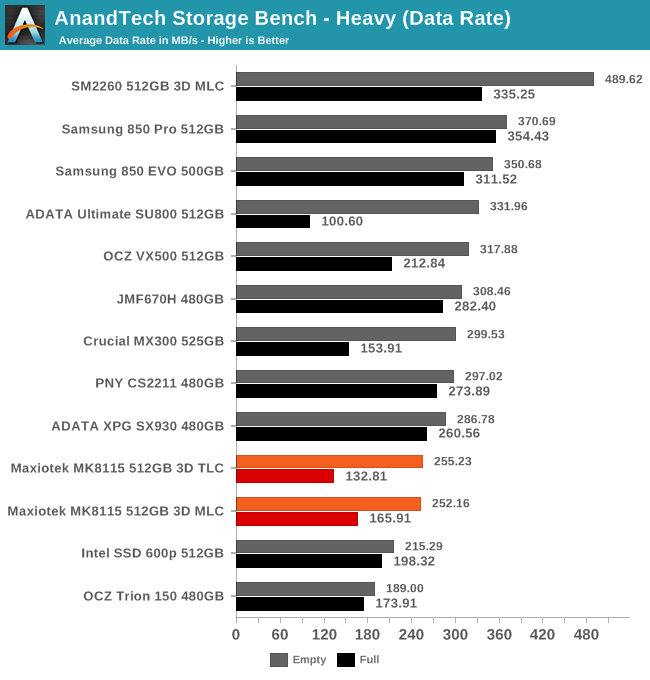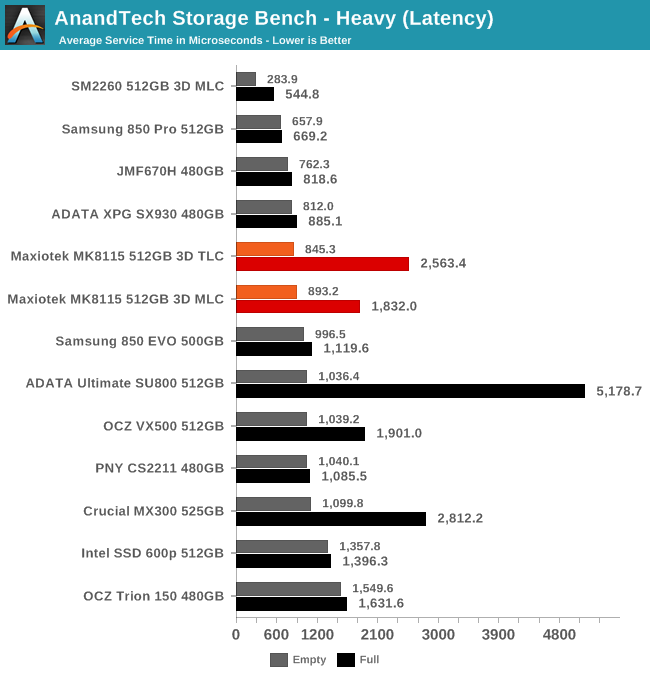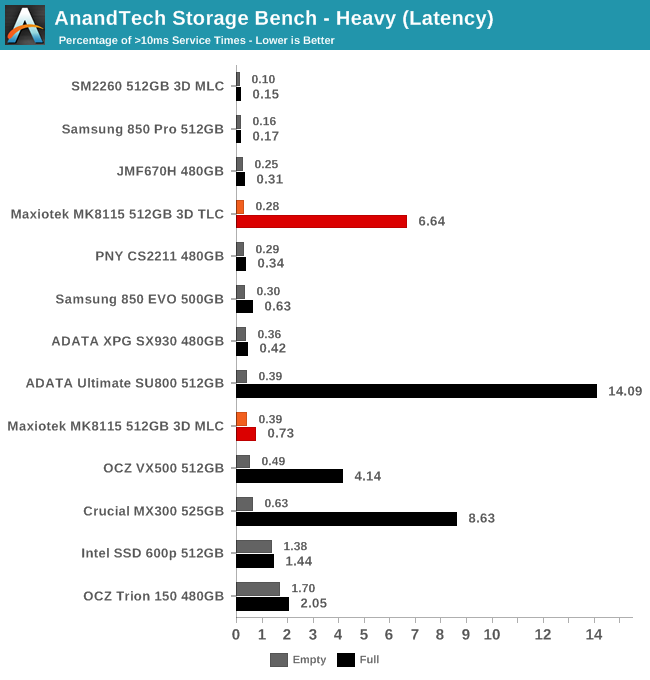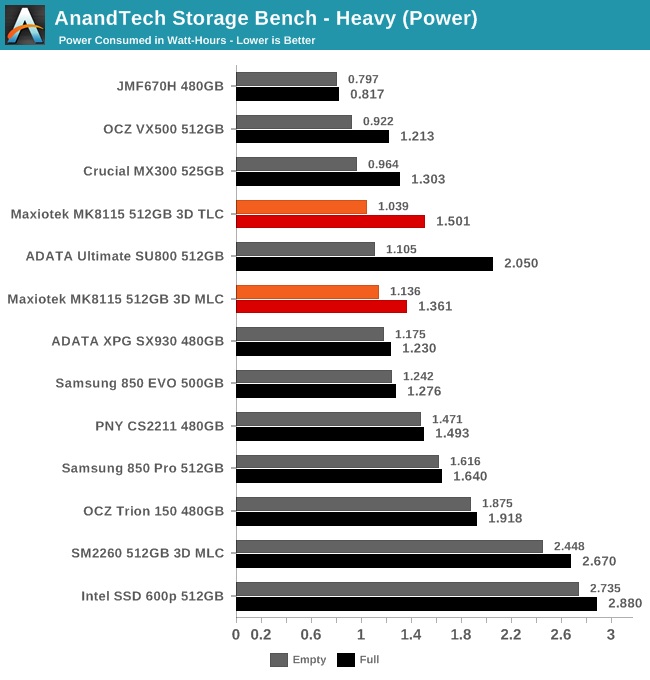Previewing Maxiotek's MK8115 SSD Controller: Can DRAM-less Drives Make The Cut?
by Billy Tallis on May 9, 2017 8:00 AM ESTAnandTech Storage Bench - Heavy
Our Heavy storage benchmark is proportionally more write-heavy than The Destroyer, but much shorter overall. The total writes in the Heavy test aren't enough to fill the drive, so performance never drops down to steady state. This test is far more representative of a power user's day to day usage, and is heavily influenced by the drive's peak performance. The Heavy workload test details can be found here.

The average data rates of the two MK8115 drives on the Heavy test are almost exactly the same when the test is run on an empty drive. Unfortunately that puts both of them quite near the bottom of the charts, behind the older JMicron drives and the other SATA SSDs using Micron 3D NAND.
When the test is run on a full drive, the MK8115 drives' performance suffers greatly, which has also been true of the other two SATA SSDs with Micron 3D NAND that we've tested. Most other SSDs show a far smaller degradation in performance from a full drive.

As on The Destroyer, average service times from the MK8115 drives aren't bad at all, if the test is run on an empty SSD. When the drive starts out full, average service time more than doubles, putting the MLC drive only slightly ahead of the OCZ VX500 and the TLC drive a little ahead of the Crucial MX300.

Both MK8115 drives have good control over high latency outliers when the Heavy test is run on an empty drive. The TLC sample surprisingly scores a bit better than the MLC sample. However, when the test is run on a full drive, the MLC sample's performance degradation is moderate while the TLC drive falls apart, though not quite to the extent of the Crucial MX300 or ADATA SU800.

The energy usage scores of the MK8115 drives on the Heavy test are good. The Crucial MX300 is still a bit better overall, but the Micron 3D NAND drives in general are all fairly efficient. They also all suffer noticeably when the test is run on a full drive, but it's not enough to make them worse than the slowest planar TLC SSDs or the fastest MLC SSDs that prioritize performance over power efficiency.










60 Comments
View All Comments
jabber - Tuesday, May 9, 2017 - link
Its like Video Recorders or DVD players. The first ones weighed 30 kilos and were built like they were made during the Industrial Revolution. By the time they stopped making them they weighed 3 kilos, had 70% fewer parts and were mostly plastic.Magichands8 - Tuesday, May 9, 2017 - link
Yep! Prices are getting higher in many cases even if they aren't dropping AND performance is either mediocre or just getting worse. Like I've said before, somewhere there are people buying such products. I don't know who they are or what's wrong withe them but I guess manufacturers are going to continue the trend for as long these people have money to lose. Even though it's dismaying to see I won't have much trouble waiting them out though. There's just very little value in most current offerings.MajGenRelativity - Tuesday, May 9, 2017 - link
I'm not sure of an instance where performance has dropped in the same price band over the past couple of years. Please feel free to enlighten meBrokenCrayons - Tuesday, May 9, 2017 - link
I'm one of those people buying such things. In my case, I was using mechanical hard disks until the middle of last year and I'm slowly (due to unusually high NAND prices) purchasing low performance SSDs for my home computers. Cheap, relatively slow SSDs still let me enjoy faster and more responsive storage. Since I'm not a power user or someone that's interested in waving around my consumer electronics like they're an extension of my reproductive organs, I have no want or need for the fastest and most expensive tier of solid state storage.While you wonder what's wrong with us for our purchases, we wonder what's wrong with you for being worried about what we buy when you can simply mind your business and buy a higher end product meant to meet your needs or desires.
MajGenRelativity - Tuesday, May 9, 2017 - link
I definitely respect your choices, as even a low-end SSD can best a HDD for metrics a typical home user would care about.melgross - Tuesday, May 9, 2017 - link
Right now, there are memory shortages. NAND shortages are expected to last until the end of the year. Then prices will begin dropping again.beginner99 - Wednesday, May 10, 2017 - link
Yeah if this continues it will take less than a year and they will actually manage to perform worse than HDDs.JimmiG - Wednesday, May 10, 2017 - link
I agree, unless you absolutely need more SSD storage right now, I'd recommend holding off until next year.MajGenRelativity - Tuesday, May 9, 2017 - link
I just hope the shortage is going to end, and we can go back to cheaper SSDs. I'm also unsure of the usefulness of this drive, but I can see it being used in systems a notch above budget systems.looncraz - Tuesday, May 9, 2017 - link
I just want a 2TB SSD that costs $200 US and performs better than a hard drive (no spin up delays, lower latency, no moving parts).I could deal with 150MB/s transfer rates and even 2ms latencies for that. Still worlds better than the hard drives I use for storage now considering I have to spin them down as they are only accessed every few hours a couple times a day (but then stream data at 40MB/s+ for a couple hours).
I would buy three without hesitation.